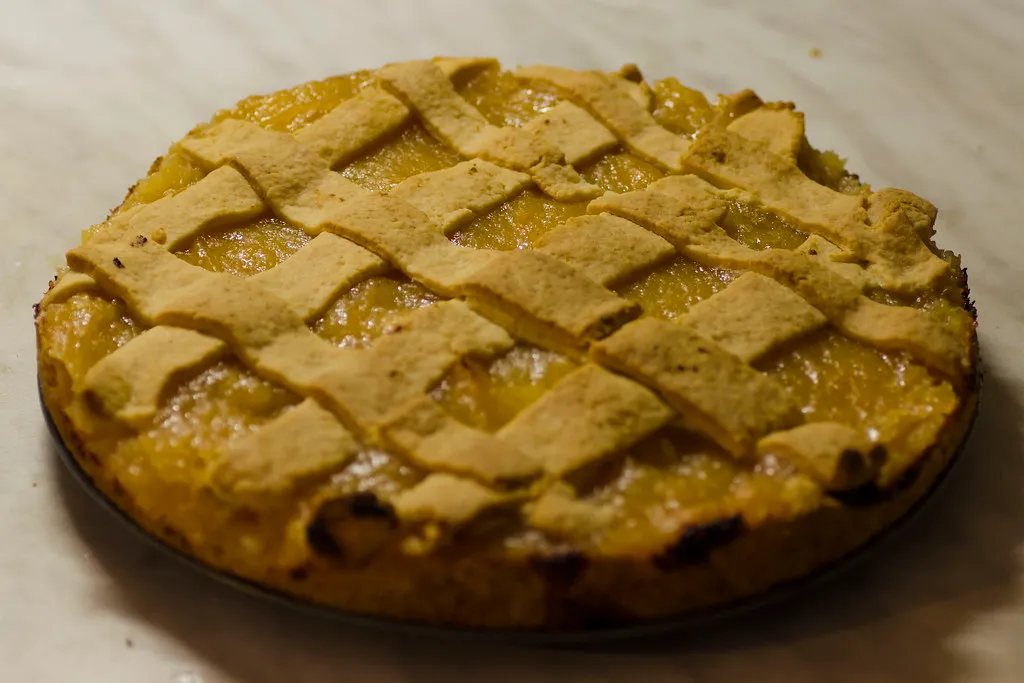The Best Fluffy Pancakes recipe you will fall in love with. Full of tips and tricks to help you make the best pancakes.
If you’ve never tasted a quince cake, you’re in for a truly enchanting dessert experience. Quince—an often-overlooked fruit with a floral aroma and tart flavor—transforms beautifully when baked, turning sweet, tender, and fragrant. In this recipe, we take this golden autumn gem and create a moist, rustic quince cake that’s as charming as it is delicious.
Perfect for cozy gatherings, fall baking, or when you want to impress with something a little different, this quince cake is a delightful twist on classic fruit-based desserts. Whether you’re new to baking with quince or already a fan of Mediterranean flavors, this recipe will quickly become a favorite.
Ready to discover the magic of quince? Let’s dive in!
What is Quince and Why You Should Bake With It

Meet the Quince Fruit
Quince is a bright yellow, pear-shaped fruit that’s been cherished for centuries, especially in Mediterranean and Middle Eastern cuisines. Known scientifically as Pyrus cydonia, quince is closely related to apples and pears but has a character all its own. When raw, its flesh is firm and tart—so much so that it’s rarely eaten uncooked. However, once simmered, poached, or baked, quince transforms into something magical: soft, fragrant, and laced with notes of honey, citrus, and rose.
Unlike more common fruits, quince is a seasonal treasure typically available in fall and early winter, making it a perfect centerpiece for cozy, comforting desserts like cakes, crumbles, and tarts.
Health Benefits of Quince
Not only is quince delicious when prepared properly, but it also comes with a variety of health benefits. It’s low in calories, rich in dietary fiber, and packed with immune-boosting vitamin C. Quince is also known to contain antioxidants and anti-inflammatory compounds, making it a wholesome addition to your fall baking.
If you’re looking for a natural way to sweeten your dessert while incorporating seasonal produce, quince is a smart and nutritious choice.
Why Quince Shines in Cakes
What makes quince so special in baking is its transformation under heat. The tough, tart flesh softens beautifully when poached or baked, turning into tender, aromatic pieces that infuse your cake with a subtle floral sweetness. Think of it as a more exotic alternative to apples or pears—one that elevates any rustic dessert into something truly memorable.
When baked into a cake, quince pairs wonderfully with warm spices like cinnamon, cardamom, and clove, as well as ingredients like honey, almonds, and olive oil. Its unique taste and silky texture add depth and character, making each bite rich, fragrant, and surprisingly light.
So if you’ve never baked with quince before, this is the perfect recipe to start with. It’s simple, flavorful, and guaranteed to surprise and delight your taste buds.
Ingredients You’ll Need for the Perfect Quince Cake
Making a quince cake is all about combining simple, wholesome ingredients with the rich flavor of poached or baked quince. This rustic yet elegant dessert doesn’t require fancy techniques—just quality components and a little seasonal magic. Here’s what you’ll need:
Key Ingredients for the Base
- All-Purpose Flour: The foundation of most cake recipes, providing structure and a tender crumb.
- Baking Powder: Essential for leavening the cake and giving it a light, fluffy texture.
- Eggs: They add richness, moisture, and help bind the batter together.
- Sugar: Regular granulated sugar works well, but you can also use a blend of white and light brown sugar for deeper flavor.
Flavor-Boosting Ingredients
- Olive Oil or Unsalted Butter: Olive oil adds a moist, Mediterranean touch and complements the fruit beautifully. Butter is also an option for a more traditional, rich flavor.
- Vanilla Extract: A dash of vanilla enhances the natural sweetness of quince and rounds out the overall flavor.
- Lemon Zest: Adds brightness and cuts through the richness, pairing beautifully with the floral notes of the quince.
- Ground Cinnamon: This warm spice brings out the cozy fall vibes and enhances the fruit’s flavor.
The Star Ingredient: Quince
- Poached Quince: Peel, core, and gently simmer quince slices in a mixture of water, sugar, and lemon until they’re tender and golden-pink. This step not only softens the fruit but also infuses it with flavor.
- Quince Preserves or Canned Quince (Optional): A time-saving alternative when fresh quince isn’t available. These can be folded into the batter or layered on top for a decorative finish.
Optional Add-Ins for Texture and Style
- Almond Flour or Ground Almonds: Replace a portion of the all-purpose flour for a nuttier flavor and a moist crumb—great if you’re going for a Mediterranean-style cake.
- Chopped Nuts (Walnuts or Almonds): Add a pleasant crunch to the cake and pair well with the tender fruit.
- Honey: A drizzle of honey over the top before or after baking can enhance the natural sweetness and give the cake a glossy finish.
- Whipped Cream or Vanilla Glaze: For serving, these toppings add a soft, creamy contrast to the dense, fruit-filled cake.
Ingredient Tips:
- If using preserved quince, reduce the sugar in the batter slightly to balance the sweetness.
- For added depth, try adding a pinch of clove or cardamom along with the cinnamon.
- Always poach quince until tender before adding it to the batter; raw quince will not soften enough during baking.
This combination of wholesome pantry staples and seasonal fruit creates a dessert that feels both homey and refined. The beauty of quince cake is that it’s easy to customize—so feel free to adapt based on your taste and what’s in your kitchen.
Step-by-Step: How to Make This Easy Quince Cake
Creating a quince cake might sound fancy, but it’s actually quite simple and very rewarding. Whether you’re using fresh poached quince or high-quality preserves, this step-by-step guide will walk you through the entire process. The result? A moist, fragrant cake that’s perfect for tea time, holidays, or a cozy evening treat.
1. Prepare the Quince
Start with fresh quince if available:
- Peel, core, and slice the fruit into even wedges or thin slices.
- In a saucepan, combine water, sugar (about 1 cup), a splash of lemon juice, and optionally a cinnamon stick.
- Simmer the quince for about 30–40 minutes until the slices turn rosy-pink and become tender. This poaching process enhances the flavor and softens the fruit beautifully.
Shortcut:
- If you’re using quince preserves, canned quince, or membrillo (quince paste), simply drain and slice or dice as needed. These options work great when you’re short on time.
2. Mix the Dry Ingredients
In a large mixing bowl, whisk together:
- 1½ cups all-purpose flour
- 1 tsp baking powder
- ½ tsp ground cinnamon
- Pinch of salt
Optional: Add ¼ cup of almond flour for extra richness and a subtle nutty flavor.
3. Combine the Wet Ingredients
In a separate bowl, whisk:
- 2–3 large eggs
- ¾ cup granulated sugar (reduce slightly if using sweet preserves)
- ½ cup olive oil or melted unsalted butter
- 1 tsp vanilla extract
- 1 tsp finely grated lemon zest
Whisk until the mixture is light and smooth.
4. Bring It All Together
- Gently fold the dry ingredients into the wet mixture. Mix just until combined—overmixing can lead to a dense cake.
- If using chopped quince or preserved slices, fold them into the batter or layer them on top for a beautiful rustic look.
- Pour the batter into a greased and parchment-lined 8-inch round or square cake pan. For easy and even baking, I recommend using a quality pan like the Ninja Foodi Multi-Purpose Pan, which ensures even heat distribution and easy cleanup..
5. Bake and Cool
- Preheat your oven to 350°F (175°C).
- Bake for 35–45 minutes, or until a toothpick inserted in the center comes out clean and the top is golden brown.
- Let the cake cool in the pan for about 10–15 minutes before transferring it to a wire rack to cool completely.
Optional: Dust with powdered sugar or drizzle with a simple honey-lemon glaze for a glossy finish.
Serving Suggestions
- Serve warm with a dollop of whipped cream or Greek yogurt.
- Add a scoop of vanilla ice cream for a decadent dessert.
- This cake also tastes even better the next day as the flavors deepen—perfect for make-ahead entertaining.
This easy quince cake recipe celebrates the unique qualities of the quince fruit while keeping the method approachable for any home baker. Whether you’re making it for a special gathering or just because you love trying new flavors, this cake is sure to impress.
Tips for the Best Quince Cake Every Time
Baking with quince can feel like discovering a hidden gem in the world of desserts—and with a few helpful tips, you can make your quince cake not just good, but unforgettable. From flavor-boosting ideas to texture tricks, here’s how to make sure your cake turns out perfectly every time.
1. Always Poach Fresh Quince First
Quince is naturally hard and tart, and won’t soften enough just by baking.
Tip: Simmer peeled and sliced quince in a mix of water, sugar, and lemon juice for about 30–40 minutes until soft and lightly pink. You can do this a day ahead and refrigerate until ready to use. The poaching liquid also makes a delicious glaze or syrup for the finished cake!
2. Balance the Sweetness
Quince has a tart edge that’s wonderful, but it can be overpowering if not balanced.
Tip: Adjust the sugar in your recipe depending on whether you’re using fresh poached quince, sweet preserves, or quince paste. Taste your fruit before baking and reduce the sugar in your batter slightly if the quince is already very sweet.
3. Use Olive Oil for Extra Moisture and Flavor
Olive oil not only adds a subtle fruity note that complements quince, but it also keeps the cake moist for days.
Tip: Use a high-quality extra virgin olive oil for the best flavor, or opt for melted unsalted butter if you prefer a richer, more classic taste.
4. Layer Quince for a Beautiful Look
This cake is as beautiful as it is tasty.
Tip: For a rustic, Instagram-worthy presentation, arrange thin slices of poached quince on top of the batter before baking. They’ll caramelize slightly in the oven and give your cake a gorgeous finish—no decorating skills required.
5. Let It Rest for Deeper Flavor
Like banana bread or spice cake, quince cake gets better as it sits.
Tip: Bake your cake a day ahead if you can. The flavors will meld together beautifully, and the texture becomes even more moist and tender.
Bonus Tips:
- Spice it up: Add a pinch of cardamom or ground ginger for a warm, aromatic twist.
- Nutty texture: Fold in chopped walnuts or almonds for crunch and contrast.
- Keep leftovers moist: Store in an airtight container at room temperature for up to 3 days, or refrigerate for longer shelf life.
With these tips in your back pocket, baking a perfect quince cake will feel effortless and rewarding. Whether you’re a seasoned baker or trying quince for the first time, these simple adjustments will help you get the most flavor, texture, and wow-factor out of your ingredients.
FAQs and Serving Ideas
Quince cake is a unique and delightful dessert that might bring up some questions, especially if you’re new to this fragrant fruit. Below, we’ve answered some of the most common queries and shared creative serving ideas to help you enjoy your quince cake to the fullest.
Frequently Asked Questions (FAQs)
Q1: Can I use canned or preserved quince instead of fresh quince?
Yes! Canned or preserved quince, such as quince paste or quince preserves, can be a great time-saver. Just make sure to adjust the sugar in your recipe accordingly since preserved quince tends to be sweeter than fresh poached fruit. You can fold it directly into the batter or layer it on top before baking.
Q2: What does quince taste like?
Quince has a tart, slightly astringent flavor when raw, but once cooked, it softens and develops a sweet, floral, and fragrant taste, often compared to a mix of apple, pear, and hints of citrus and rose.
Q3: Can I make quince cake gluten-free?
Absolutely! Substitute the all-purpose flour with a gluten-free flour blend that includes xanthan gum or other binders. Almond flour can also add great texture and flavor but usually works best when combined with a gluten-free flour mix.
Q4: How should I store leftover quince cake?
Store leftovers in an airtight container at room temperature for up to 3 days. For longer storage, refrigerate the cake for up to a week. You can also freeze slices individually wrapped for up to 3 months—just thaw at room temperature before serving.
Q5: Can I add nuts or other fruits to the cake?
Yes! Chopped nuts like walnuts, almonds, or pistachios add a lovely crunch, while dried fruits such as raisins or chopped dates can provide extra sweetness and texture. Just fold them gently into the batter before baking.
Serving Ideas to Elevate Your Quince Cake
1. With Whipped Cream or Greek Yogurt
A dollop of lightly sweetened whipped cream or tangy Greek yogurt complements the floral sweetness of quince cake beautifully, adding creamy richness without overpowering the delicate flavors.
2. Drizzled with Honey or Citrus Glaze
For an elegant finish, drizzle warm honey or a simple glaze made from powdered sugar and fresh lemon juice over the top. This adds a glossy sheen and an extra layer of flavor that highlights the quince.
3. Paired with Ice Cream or Sorbet
Vanilla ice cream is a classic pairing, but consider serving your quince cake with a scoop of citrus sorbet or a subtly spiced gelato (like cinnamon or cardamom) for a refreshing contrast.
4. As Part of a Tea or Coffee Spread
Quince cake’s delicate flavor makes it a perfect accompaniment to afternoon tea or coffee. Serve it alongside other light pastries and finger sandwiches for a charming dessert table.
5. With Toasted Nuts or Fresh Fruit Garnish
Add a sprinkle of toasted almonds or pistachios on top for crunch and color. Fresh berries or thin slices of poached quince on the side can also brighten the presentation and add freshness.
Quince cake is a versatile dessert that can be dressed up or enjoyed simply. With these FAQs and serving ideas, you’ll be well-prepared to make the most of this unique and delicious treat, whether it’s for a casual family dessert or a special occasion.





